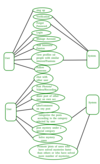Diagrams (including UML) Flashcards
(18 cards)
Volere Snowcard

LAMP stack
Linux, Apache Webserver, MySQL database and PHP
This also incoperates a client-server achitecture

Skype architecture/ Peer-to-peer
User is connected to nearest interconnected hubs called a super node. A super node then routes telephone calls from one user to another, maybe even via other supernodes.
This is also known as Peer to Peer

Pipe and Filter Architecture

Six princile steps of TDD
- Decide on a code increment.
- Decide on a test.
- Write the test.
- Run all tests, expecting the new test to fail (so that you know that the test has ‘teeth’).
- Write the code.
- Run all the tests and succeed.

Waterfall Model
https://melsatar.blog/2012/03/15/software-development-life-cycle-models-and-methodologies/

V-Shaped Model
https://melsatar.blog/2012/03/15/software-development-life-cycle-models-and-methodologies/

Agile Model
https://melsatar.blog/2012/03/15/software-development-life-cycle-models-and-methodologies/

Iterative Waterfall Model

Star Model

Interaction Design Model

Structured-Case Model

Spiral Model

Six- Part Model - Quality Attribulte Scenario
- The source is a human actor, another system, or anything else that can generate a stimulus.
- The stimulus is any kind of event or request.
- The artefact is what will respond to the stimulus. It might be a running component or service if we are considering performance for example, but it could be code or documentation if we are interested in maintainability.
- The environment specifies the conditions which the scenario assumes the artefact will be operating under. For instance if we are concerned with performance the environment might be either ‘normal operation’ or ‘overloaded’.
- The response is what happens as a result of the artefact receiving the stimulus.
- The response measure is an objective yardstick by which we can test if the requirement has been met.
Excerpt From: The Open University. “TM354 Block 3 Unit 10”. Apple Books.

Statechart / State Machine
https://t2informatik.de/en/smartpedia/state-diagram/

Use Case (Graphical)
https://www.geeksforgeeks.org/designing-use-cases-for-a-project/

Use Case (Textutal Description)

Software Development Cycle (6 key elements)
https://relevant.software/blog/7-steps-for-effective-software-product-development/



